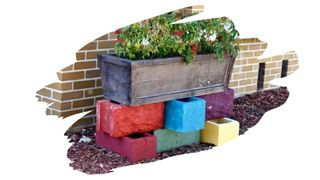Must you always stick to using natural wood for a raised bed? Not always, since not every garden bed has to be made out of solid natural wood.
For example, cinder blocks, (also referred to as concrete blocks), are a popular alternative to using timber. Especially when it comes to building a garden bed that is both durable and affordable.
But, is that cinder block raised bed really safe enough to grow your vegetables in?
Well, in this post, you’ll discover the safest type of material you can use for any raised bed. You’ll also learn why cinder blocks can end up overheating in-ground soil. And keep reading to find out which two specific types of timber are ideal for a raised garden bed.

This post may contain affiliate links to products that we receive a commission for (at no additional cost to you). Learn more here.
What Is The Best Material For A Raised Garden Bed?
First and foremost, you need your garden bed to be made from material that doesn’t contain harmful chemicals. That’s because there’s a risk of those chemicals leeching into the soil (and harming your plants).
You also want to make sure that the material is durable as well. The great outdoors can be harsh, and between sunshine and rain, you need material that’s resistant to rot and bugs.
So, by far, the safest and best material is going to be durable stable untreated timber. And wood types such as Red Western Cedar and White Oak, are amongst the best choice lumber for your garden bed.
Related Post: Railroad Ties Vs Pressure Treated Fence Posts: Which One’s Best For Your Garden?
But What’s The Cheapest Way To Make A Raised Bed?
Well, quality durable wood is not the cheapest material, that’s for sure. What’s more, even wood that’s been treated with wood preservatives, can decay away in a matter of years.
That’s why other garden bed options, such as bricks and cinder blocks, are a cost-saving alternative. They last longer, can handle all weather conditions, and don’t need sealers or treatments.
Related Post: How To Keep Your Landscape Timbers From Ever Warping Again
So, Is It OK To Used Cinder Blocks For Raised Garden Beds?
If you want to save money and time, then you can go with cinder blocks. However, if you live in a very warm climate — or summertime tends to get very hot in your area — then you might want to avoid using cinder blocks.
Why? Will Plants Grow In Cinder Blocks?
Yes they will. A wide variety of vegetables can happily grow in the soil contained in that cinder block bed. But, you may have problems managing the temperature of the soil, if you use cinder blocks.
Raised beds — by their very design — already make in-ground soil warm up efficiently. This is generally a good thing for plants, especially during colder months.
However, cinder blocks are fantastic at holding in heat. There’s a reason why they’re so frequently used to make fire pits.
Which means that on very hot days, cinder blocks can over-heat that in-ground soil. And that in turn can make things much too warm for plants — especially on sustainably hot days.
And all of this doesn’t even take into account the chemicals used to form cinder blocks in the first place.
Cinder blocks are made mostly out of cement. And cement contains silica sand, aluminum, iron, and a bunch of other chemical ingredients.
Are Concrete Blocks Too Toxic For Gardens?
Well, cement is pretty toxic to us. It can cause skin irritations, respiratory issues, and other severe allergic reactions.
But generally, cement isn’t toxic to plants (at least in its solidified form). However, some of the ingredients in cement cinder blocks — if they manage to soak into the ground — can mess up the pH levels of soil.
And that in turn means that plants will struggle to grow in that raised bed.
So, Should You Always Stick To Untreated Wood For A Raised Garden Bed?
Well, for the safety of your plants, yes.
This isn’t to say that a cinder block raised bed is a bad alternative. It’s just that untreated durable wood is the least likely to overheat your in-ground soil…or soak chemicals into it.
What Is Untreated Wood Exactly?
Basically, untreated wood does not contain any chemical preservatives. And generally, wood needs these preservative additives in order to stave off rot and bugs.
Treated wood (such as pressure treated wood) has been infused with wood preserving chemicals. Even green treated timbers will have been put through a process that saturates them with these rot-resisting additives.
Related Post: A Quick Guide To Painting Landscape Timbers (+ 3 Easy Time Saving Tips!)
Now, if you don’t treat wood it will rot away quite quickly. Yet certain types of wood, such as White Oak, have natural moisture-resistant qualities to them. And those qualities allow them to shrug off rot…even without any wood preservatives.
You can learn more about White Oaks natural durability right here on The Woodwork Place by checking out our post: Can You Really Use Untreated Oak For Raised Beds?
To Wrap Up, Here Are The 3 Key Takeaways From This Post…
- 1). The best material for a raised garden bed is natural untreated and durable solid wood.
- 2). Cinder blocks are made from concrete. And this material can over-heat in-ground soil during summer months.
- 3). So instead, use weather-resistant timber, such as Red Western Cedar and White Oak, for your raised bed.



